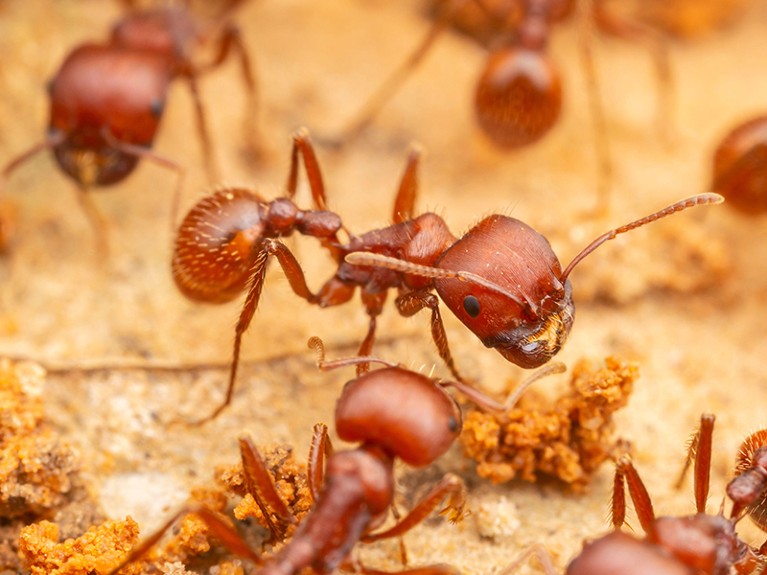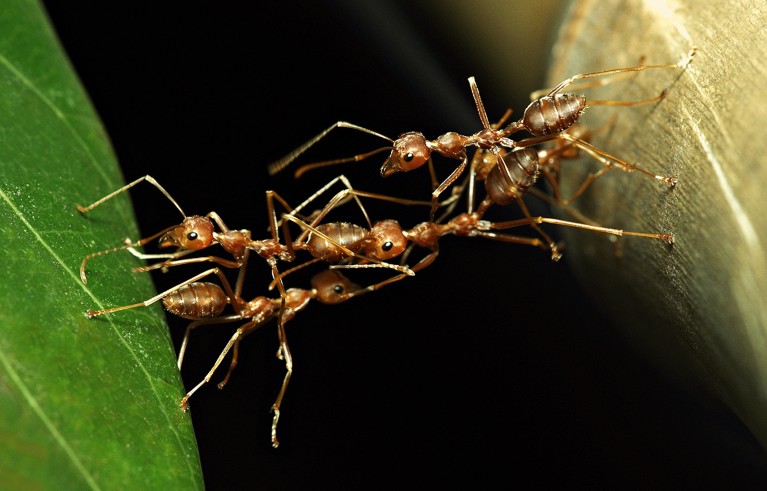The Ecology of Collective Behavior Deborah M. Gordon Princeton Univ. Press(2023)
Collective behaviours are present throughout nature — from groups of genes being activated simultaneously to shoals of fish swimming in unison for protection against predators and mounds of insects working together to build nests. But biologist Deborah Gordon worries that the evolutionary biologists who study how these phenomena evolved are missing a trick, because they often don’t consider that the ever-changing environments in which animals live are fundamental to shaping such behaviours. In The Ecology of Collective Behavior, she tries to set the record straight.
Gordon has spent decades studying the natural history of two ant species that live in very different environments, paying acute attention to how the insects’ stirring, dynamic habitats shape their behaviour. These observations form the bedrock of her book.
Survival of the nicest: have we got evolution the wrong way round?
First, she describes the red harvester ant Pogonomyrmex barbatus, which lives in the harsh, parched deserts of New Mexico. Affectionately known as pogos, these ants are deep red and around 10 millimetres long — an impressive size for an ant. They live in colonies, which contain more than 10,000 female workers, and rely on seeds scattered on the desert floor for both food and water. Seed sources change slowly throughout the year as plants wax and wane; there is mostly a plentiful and constant supply of food. But collecting seeds is hazardous. Deserts are dry, so pogos live in a catch-22 world: they must risk desiccation to gather the water they need.
Gordon shows that this delicate trade-off is achieved by a slow but robust mechanism through which foragers recruit nestmates in the search for food. When a female returns to the nest with her bounty, she releases hydrocarbons from her outer cuticle to indicate to her sisters that there’s food out in the desert.
A fleeting touch from a forager’s antennae sends others scuttling out of the nest. They head out in random directions, but that’s OK, because the seeds are spread out on the desert floor, not clustered in patches. Plentiful food and favourable environmental conditions — days that are not too hot, for instance — mean that many foragers return to the colony and recruit many others. Conversely, under bleaker circumstances, fewer ants return to muster recruits. In this way, simple positive feedback regulates the steady collective behaviour of thousands of ants.
Bumblebees show uniquely human behaviour
Next, Gordon turns to the arboreal turtle ant, Cephalotes goniodontus, which forages in the canopies of Mexico’s dry tropical forests. Unlike the desert harvesters, turtle ants spread their brood across many nests perched in the canopy, connected by a complex net of tangling vines, shifting leaves and moving stems. Their food sources are ephemeral — foragers must exploit bursts of nectar from transient floral blooms.
Each foraging turtle ant lays a trail of pheromones wherever she goes — independent of whether she has discovered a food source or not — while following the trails laid by others. These trails constantly bifurcate, and paths can change on an hourly basis. Which route should each forager follow?
The answer is simple, Gordon reveals. The ants follow the smelliest path — the one with the strongest pheromone signal — and keep reinforcing profitable trails until something tells them to stop, such as the presence of a predator or a broken branch. This ensures that the ants can find the most lucrative foraging spot and rapidly adjust the information flow if needed, changing their behaviour in a constantly changing environment.

Red harvester ants clean their nest together.Credit: Clarence Holmes Wildlife/Alamy
Unpredictable environments
Pogos and turtle ants solve similar problems in distinct ways. How they do it is dictated by their environment. Gordon borrows concepts from network science to describe how turtle ants function in modules — units in which most information flow occurs — to keep communication local, enabling them to respond rapidly to the ever-changing availability of resources. By contrast, the centralized regulation of pogos is the epitome of low modularity: the nest is the sole source of communication.
Gordon argues that the nature of the environment and the resources it provides determine the types of collective-foraging mechanism that evolve — not just for ants, but for all social organisms. The extent to which ecology drives the evolution of social behaviour in this way has been overlooked, she suggests.
How STRANGE are your study animals?
I agree that researchers need to better recognize that organisms exist, and have evolved, in a dynamic, often unpredictably messy world, and to acknowledge that this influences their behaviour. I admire how the author takes inspiration not only from careful field experiments — removing ants or changing the amount of available resources and observing how the insects respond — but also from the classical science of natural history. Many evolutionary biologists could learn a lot by rediscovering this way of working.
But I am less convinced by Gordon’s suggestion that her ideas are at odds with the ‘prevailing theory’ for social behaviour. Inclusive fitness theory — an idea put forward by UK evolutionary biologist William Hamilton in 1964, and accepted widely in the field — suggests that social behaviours evolve when the benefits of cooperating with relatives exceed the costs (W. D. Hamilton J. Theor. Biol. 7, 1–16; 1964). Hamilton’s ideas stemmed from his observations of wasps, ants, bees and birds in their natural habitats, and are supported by strong experimental and theoretical evidence.
Hamilton’s theory suggests that cooperation will prevail in unpredictable environments, with some animals choosing to help raise their relatives’ young rather than having their own (P. Kennedy et al. Nature 555, 359–362; 2018). This phenomenon is seen often in the natural world, from slime moulds to termites. Thus, the idea that dynamic environments help to shape social behaviour is already part of the accepted theory of social evolution.
I think the confusion arises because Gordon conflates proximate (mechanistic) and ultimate (evolutionary) processes. Her book offers useful insights into the proximate processes that regulate collective behaviour on a day-to-day basis, and the role of the environment in shaping and maintaining such behaviours. I agree that the interactions between organisms and their environments have become increasingly overlooked because fewer researchers are studying animals in their natural environments. But these insights are not at odds with the prevailing theory of how collective behaviours evolve.
In her final chapter, Gordon remarks: “The whole appears to be more than the sum of the parts, because the parts do not sum — they intertwine, jostle, and respond.” This heartening statement is a great description of the ecological and evolutionary complexities that shape our world. It’s these complexities that all biologists should keep in mind.


 Survival of the nicest: have we got evolution the wrong way round?
Survival of the nicest: have we got evolution the wrong way round?
 Bumblebees show uniquely human behaviour
Bumblebees show uniquely human behaviour
 Claus Nielsen (1938-2024), zoologist of invertebrates
Claus Nielsen (1938-2024), zoologist of invertebrates
 How STRANGE are your study animals?
How STRANGE are your study animals?





